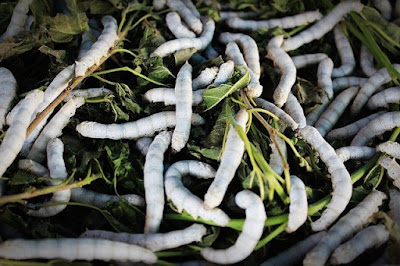SYLLABUS B.SC. PART-I TASAR TECHNOLOGY
In university B.Sc.-I year The syllabus of TASAR TECHNOLOGY consists of two papers of theory and one paper of practicals.
PAPER- I
MORPHOLOGY, ANATONY & PHYSIOLOGY OF TASAR SILKWORM &
AGRONOMY
MM: 50
UNIT – I
- 1. History of
Non-Mulberry Sericulture. - 2. Outline classification
of Non-Mulberry Silkworm, their distribution in India and other countries. - 3. General
organization and life-cycle of Antherea mylitta, & Morphology & Anatomy
of Larva, pupa & moth. - 4. Structure of
EGG, fertilization, Embryogenesis, Incubation & Hatching.
UNIT – II
- 1. Reproduction
– structure of re-productive system, oogenesis, spermatogenesis, - development & growth.
- 2. Molting and
volatise in tasar silkworm. - 3. Endocrinology
of tasar silkworm, Role of hormone in development & metamorphosis. - 4. Silk glands,
structure of silk glad, formation and biochemistry of silk.
UNIT-III
- 1. Rearing-rearing
equipment, preparation for rearing, Environmental condition for rearing of tasar silkworm. - 2. Rearing of
large, young age and late age tasar silkworm. - 3. Disinfection
and disinfectants. - 4. Mounting,
spinning & harvesting of cocoon.
UNIT-IV
- 1. Diseases of
tasar silkworm-protozoan, viral, Bacterial, Fungal, symptoms, causative agents, preventive & control Measures. - 2. Morphology
& Anatomy of primary food plants of Tasar silkworm (Terminania arjuna, Terminania tomentosa, Shorea robusta etc.) their culture methods. - 3. Outline
classification of primary & secondary food plants of tasar worm, their - distribution in India (with the special references to Chhattisgarh
and other states.)
UNIT-V
- 1. Farm
Management: selection of soil & preparation of land for tasar plant
cultivation. - 2. Propagation
of Tasar food plants-seedlings, saplings, crafting, layering. - 3. Harvesting
of Leaf. - 4. Diseases of
Non-mulberry food plants, Fungal, Bacterial, Viral, deficiency, Insect pest, control method.
SYLLABUS B.SC. PART-I TASAR TECHNOLOGY
PAPER-II
TASAR SILKWORM–GENETICS AND BREEDING
MM: 50
UNIT-I
- 1. Moth
Emergence: pairing, ovi-position, moth examination. - 2. Incubation
of univaltine, bivoltine and multivoltine eggs. - 3. Preparation
of loose eggs-Advantages of loose eggs, handling of loose eggs. - 4. Seed
Technology: seed areas and importance of quality seed in tasar industry.
UNIT-II
- 1. Seed cocoon:
Harvesting of cocoon, gradation and selection consignment for processing. - 2. Storage
& preservation of cocoon: Types of building, methods of storing-problems
care in different season. - 3. Grainage:
Definition, model grainage house, location, orientation and grainage - equipments, condition required in grainage work.
- 4. Hybridization
– Inter-specific & Intra specific with special reference to tasar. Its
impact & future prospects.
UNIT-III
- 1. Breeding-methods
and its application, qualitative and quantitative improvement by breeding. - 2. Breeding of
Tasar silkworm: Aims, pre-requirements, variability selection for breeding. - 3. Inbreeding:
Advantage and dis-advantage, exploitation of inbreeding of non-mulberry silkworms, general and specific combining. - 4. Selection:
Methods of selection, criteria of selection, individual and batch selection.
UNIT-IV
- 1. Structure of
typical animal cell, mitosis & meiosis, chromosome number of different Non-mulberry silkworm. - 2. Hereditary
traits, in tasar silkworm-Egg, Larvae and pupae. - 3. Mutations:
Type of mutation, spontaneous and induced, chemical mutagens, effect of radiation.
UNIT-V
- 1. Polyploidy:
Nature and induction of polyploidy. - 2. Genetics of
larval and cocoon characters, - 3. Silkworm
races: Univoltine, bivoltine and multivoltine races of different tasar
silkworm. - 4. Maintenance
of races and basic seed of different silkworm.
TASAR TECHNOLOGY B.SC. 1 YEAR
PRACTICAL
TASAR SILKWORM–GENETICS AND BREEDING
Morphology, Anatomy & Physiology of Tasar Silkworm &
Agronomy.
Tasar Silkworm-Genetics and Breeding
- 1. Morphology:
tasar silkworm egg. Larva, pupa & moth. - 2. Embryology:
identification of different stages in development, - 3. Molting of
embryo. - 4. Whole mount
of larva, mouth parts, spinneret, gonad and spiracle celli. - 5. Model rearing
house: preparation for teaser rearing plots. - 6. Disinfection:
disinfection of room plot and equipment. Spraying and fumigation, material required. - 7. Harvesting
of cocoon: assessment of cocoon. - 8. Maintenance
of rearing record. - 9. Qualify test
of cocoons for breeding. - 10. Diseases:
identification of diseases of teaser worms. - 11. Microscopic
examination: handling of dead and diseased worms and sample examination. - 12. Preservation
of diseased specimen of food plant of tasar. - 13. Identification
of different diseases of tasar food plant. - 14. Morphological
studies of food plants of tasar worms. - 15. Anatomy:
anatomy of root, stem, leaf of food plant of tasar worms. - 16. Collection
of herbarium of different food plants pf tasar silkworms. - 17. Rearing
appliances: estimation of rearing appliances. For 50 dfls. - 18. Incubation
of silkworm eggs: black boxing and hatching. Recording of temperature and humidity. - 19. Molting:
identification & care. - 20. Montages
& harvesting. - 21. Mitotic
& meiotic chromosome of non-mulberry silkworm. - 22. Visits to
the areas of districts of Chhattisgarh to study tasar industries.
Scheme of Practical Examination
|
S.No.5
|
Practical
|
Marks
|
|
1
|
Morphology &
|
10
|
|
2
|
Embryological Stages of
|
8
|
|
3
|
Identification of
|
8
|
|
4
|
Morphology and Anatomy of
|
6
|
|
5
|
Assessment of Cocoon
|
5
|
|
6
|
Field Work
|
4
|
|
7
|
Viva
|
4
|
|
8
|
Sessional & Record
|
5
|
|
|
total
|
50
|
